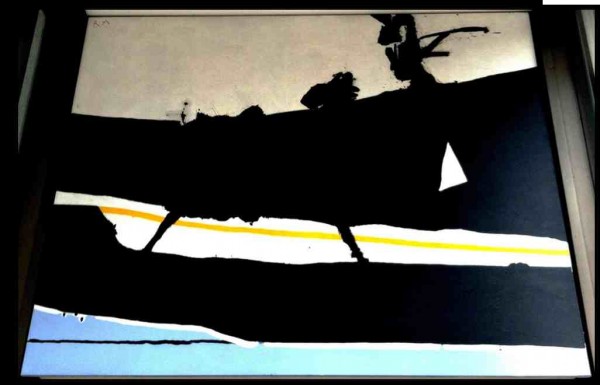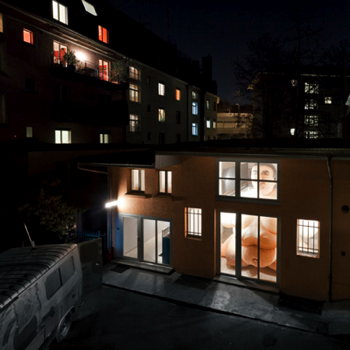Art
Toyota’s Portrait-Drawing Car
As you drive, the car draws a portrait of you, based on how you drive.
Posted By: Alex - Thu Oct 31, 2013 -
Comments (1)
Category: Art, Cars
Suicide Machines
Created by artist Thijs Rijker. They're not machines that help people commit suicide. Instead, they're machines that slowly destroy themselves.One machine saws into its own structure, until eventually the saws will reach the engine. Another machine pours sand into its gearbox until the gears wear out.
Perhaps it's a metaphor for the planned obsolescence of modern consumer goods, which are designed to break down or wear out sooner rather than later, so that we constantly have to buy new stuff.
Posted By: Alex - Mon Oct 21, 2013 -
Comments (6)
Category: Art, Technology, Suicide
Abstract Controversy

This painting was commissioned and displayed in a public building in the 1960s. It immediately aroused ire and controversy and disgust. Can you guess why?
Answer after the jump.
More in extended >>
Posted By: Paul - Sun Oct 20, 2013 -
Comments (7)
Category: Art, Confusion, Misunderstanding, and Incomprehension, Death, Politics, 1960s
Mystery Painting

Posted By: Alex - Sun Oct 06, 2013 -
Comments (7)
Category: Art
Eye Painting

Posted By: Alex - Fri Oct 04, 2013 -
Comments (3)
Category: Art
Folkicide: Empire of the Ants
FOLKICIDE: Empire of the Ants from Mikal Shapiro on Vimeo.
As someone who does his own collages, I appreciate the inventiveness of these weird ones.
Posted By: Paul - Thu Oct 03, 2013 -
Comments (2)
Category: Art, Surrealism, Insects and Spiders, Music
Too Fat To Fail
Artist Jeremie Maret installed a giant inflatable man inside his Zurich gallery. He calls the thing "Too Fat To Fail." Maret's gallery also doubles as a mini-hotel. He rents out two rooms — for those who want the full giant-inflatable-man experience. [via Dezeen]
Posted By: Alex - Thu Sep 26, 2013 -
Comments (6)
Category: Art
CMYK
CMYK by Marv Newland, National Film Board of Canada
More trippy stuff to start your weekend.
Posted By: Paul - Fri Sep 20, 2013 -
Comments (2)
Category: Art, Products, Cartoons
Project Apology
South African artist Paul Roux has launched "Project Apology." This involves him "undertaking to apologize, in person and as a member of humanity, to non-human species on the planet that are being adversely affected by human activity."In this picture, you see him apologizing to a clam. And in the video below, he apologizes to a flock of birds.
Posted By: Alex - Mon Sep 16, 2013 -
Comments (8)
Category: Art
Time Management by Jonathon Keats
Artist Jonathon Keats, whose career we've been watching for some time here at WU, has sent us a personalized email to let us know of his latest project. Which means he knows we're watching him, and he's watching us back. It's like a closed circle of weirdness!His latest project involves time management. Traditionally this involves being managed "by corporate decree or motivational techniques." But his idea is to manage time itself using the principles of relativity.
It's known that gravity warps the fabric of time, so that time runs slower for objects near a high-gravity object (such as a star or planet) relative to an object not near such an object. So he's formed a company, Spacetime Industries, which is selling a "time ingot" that can be placed beside your bed or on your desk for "temporal micromanagement."
The ingot is made of a "high-density alloy that warps the four-dimensional fabric of the universe" that slows time for those in its vicinity. How much slower? You'll gain an extra second of time every billion years. And this extra second will only cost you $29.99.
Keats is holding a special event on Sep 26th at the Modernism Gallery in San Francisco to demonstrate the use of time ingots and answer questions. You can read more about his project here [PDF].

Posted By: Alex - Sat Sep 14, 2013 -
Comments (8)
Category: Art

| Who We Are |
|---|
| Alex Boese Alex is the creator and curator of the Museum of Hoaxes. He's also the author of various weird, non-fiction, science-themed books such as Elephants on Acid and Psychedelic Apes. Paul Di Filippo Paul has been paid to put weird ideas into fictional form for over thirty years, in his career as a noted science fiction writer. He has recently begun blogging on many curious topics with three fellow writers at The Inferior 4+1. Contact Us |






